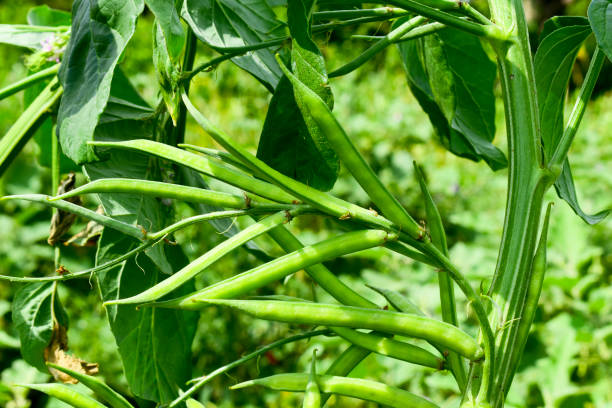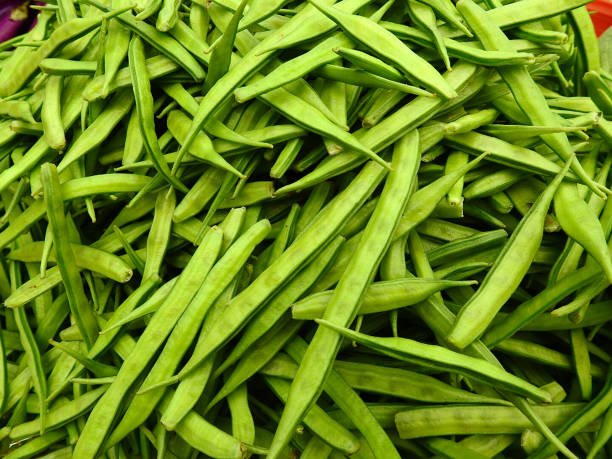

Cyamopsis tetragonoloba (L.) Taub.
|
It is commonly known as Guwar and belongs to the Fabaceae family. Pods and leaves are consumed as vegetables. 3-epikatonic acid (3β-hydroxyolean- 12-en-29-oic acid) (Saponin), Avenasterol (Slerol), Colchicine (Phenolic compound), Chrisin (Flavonoid) are among some of bioactive compounds found in it. Gum C-glycosylated derivative (GG) and sulphated derivative (SGG) of C. tetragonoloba incresed proliferation of macrophage and phagocytosis activity and also inhibited the stimulated NO and TNF-α, in LPS stimulated RAW 264.7. Mode of Consumption : Fried and boiled |
| Plant Details | Agro-climatic Zone | Vernacular Names | Pictures |
| Scientific Name: Cyamopsis tetragonoloba (L.) Taub. Family: Fabaceae Lindl. Class: Magnoliopsida Order: Fabales Genus: Cyamopsis DC. Fruiting Season: October to December Parts: Pods & Leaves |
|
Andhra Pradesh : Goru-chikkudu-kaya Bihar : Gawar, Guwar, Guaar, Goaar Delhi : Gawar, Guwar, Guaar, Goaar Goa : Midkisaang Gujarat : Gavar/Guvar Haryana : Gawar, Guwar, Guaar, Goaar Jharkhand : Gawar, Guwar, Guaar, Goaar Karnataka : Gori kaay Kerala : Kothavara, Cheeniamara, Kothamara Madhya Pradesh : Gawar, Guwar, Guaar, Goaar Maharashtra : Bavachi, Govari, Gavar, Citaki, Gavari Mizoram : Kaura kasaila, Phali guar, Safaid moth Odisha : Guanra chhuim, Shimba Punjab : Kaura kasaila, Phali guar Rajasthan : Gawar, Guwar, Guaar, Goaar Tamil Nadu : Kottavarai Telangana : Goru-chikkudu-kaya Uttar Pradesh : Gawar, Guwar, Guaar, Goaar Uttarakhand : Gawar, Guwar, Guaar, Goaar West Bengal : Jhar sim |
 Plant with pods  Pods |
| Compound/Extract | Activity | Mode of Action | Marker/References |
| Gum C-glycosylated derivative and sulphated derivative | Anti-inflammatory, Anticancer | Gum C-glycosylated derivative (GG) and sulphated derivative (SGG) enhanced the macrophage proliferation and phagocytosis but strongly inhibited the stimulated NO and TNF-α, in LPS stimulated RAW 264.7. | NO and TNF-α[2] |
| Major Class | Metabolites (Content of bioactives: mg/100g Fresh Weight) |
| Alkaloid | Caffeine: [3] |
| Carboxylic Acid | Ferulic acid: , Gallic acid: [3] |
| Coumaric Acid | p-hydroxycinnamyl alcohol: [4] |
| Flavonoid | Astragalin: , Catechin : , Chrisin: , Kaempferol: , Naringenin: , Rutin: [3] |
| Flavonol | Daidzein: [4] |
| Heterocyclic Compound | Ellagic Acid [ 2,3,7,8-Tetrahydroxychromeno[5,4,3-cde]chromene-5,10-dione]: , Genistein [5, 7-dihydroxy-3- (4-hydroxyphenyl)-4H-1-benzopyran4-one, 4', 5, 7-trihydroxyisoflavone]: [4] |
| Phenol | Caffeic acid: , Caffic acid: , Catechol: , Coniferyl alcohol: , Coumarin [2-Benzopyrone, 2H-1-Benzopyran-2-one]: , Diadezin [7-Hydroxy-3-(4-hydroxyphenyl) chromen-4-one]: , Quercetin [ 2-(3,4- dihydroxyphenyl)-3,5,7- trihydroxy- 4H- chromen- 4-one]: [4] |
| Phenolic acid | Gentisic acid: [4] |
| Phenolic compound | Colchicine: , p-coumaric acid: , Syrengic: [3] |
| Phytosterol | Stigmasterol: [4] |
| Phytosterols | β-Sitosterol: [4] |
| Saponin | 3-epikatonic acid (3β-hydroxyolean- 12-en-29-oic acid): [4] |
| Sterol | Campesterol: [4] |
| Sterols | Avenasterol: [4] |
| Effect | Observation | DOI |
| Disease | Formulation | Reference | Author | TKDL |
| Information from Wealth of India | Reference |
|
CSIR(1950).The Wealth of India, Raw materials,Vol.-II ,P.407-408, New Delhi, India |
| 4.2, 04.2.1, 04.2.1.1, 04.2.1.3, 04.2.2.5, 04.2.2.6, 04.2.2.8 |
|
| CSIR-North East Institute of Science and Technology, Jorhat-6, Assam, India
CSIR-Institute of Himalayan Bioresource Technology, Palampur-61,Himachal Pradesh, India |